Recycling of a Concrete Pavement after over 80 Years in Service
Abstract
:1. Introduction
2. Materials and Methods
2.1. Materials
2.2. Methods
- —
- Obtain a simplified petrographic description according to EN 932-3:1999/A1:2004 [12],
- —
- Determine the compressive strength of concrete according to EN 12390-3:2019 [13],
- —
- Determine the density of concrete according to EN 12390-7:2011 [14],
- —
- Determine the water absorption of concrete according to the Polish Standard No. PN-B-06250:1988 [15],
- —
- Determine the F150 freeze-thaw resistance of concrete according to the Polish Standard No. PN-B-06250 [15],
- —
- Determine the porosity characteristics in hardened concrete according to EN 480-11:2008 [16],
- —
- Determine the freeze-thaw resistance with de-icing salts according to EN 1340:2004/AC:2007 [17].
- —
- Determination of resistance to fragmentation by the Los Angeles test method according to EN 1097-2:2010 [18],
- —
- Determination of water absorption of analysed aggregates according to EN 1097-6:2013-11 [19],
- —
- Determination of aggregate resistance to cycling action of freezing and thawing according to EN 1367-1:2007 [20],
- —
- Determination of California bearing ratio (CBR) according to 13286-47:2012 [21].
3. Results and Discussion
3.1. Petrographic Examination of Aggregate according to EN 932-3:1999/A1:2004
3.2. Hardened Concrete Properties
3.2.1. Density
3.2.2. Compressive Strength
3.2.3. Water Absorption
3.2.4. Determination of Freeze-Thaw Resistance
3.2.5. Determination of Resistance to Ice Melt (De-Icing) Salts
3.3. Parameters of Concrete Sampled from the Road Pavement on the Section of S22 Road Between Elbląg and the State Border of Poland.
3.4. Air Void Analysis of Hardened Concrete
- —
- Total air content A%,
- —
- Specific surface of the air void system α mm−1,
- —
- Spacing factor L mm,
- —
- Micro air void content (amount of air voids below 0.3 mm in size) A300%,
- —
- Paste-air ratio R%.
3.5. Recycling of Concrete Pavement
3.6. Discussion
4. Conclusions
- (1)
- The test of compressive strength was 65.8 MPa for the upper layer and 51.2 MPa for the lower layer. With the compressive strength value in excess of 50 MPa, the tested concrete can be rated as at least CC40.
- (2)
- The freeze-thaw resistance values after 150 cycles of alternate freezing and thawing testify to a very high quality and durability of the concrete in question.
- (3)
- The air void analysis showed that the analyzed concrete contained 1.6% of micropores, i.e., air voids smaller than 300 μm (A300), the spacing factor, in turn, was below 0.200 mm (L = 0.185 mm). The air void analyses of the samples of the over 80-year-old concrete of the A6 motorway pavement showed that the concrete satisfies the contemporary requirements specified for PCC pavements, which confirms the long-lasting, perpetual character of pavements of this kind.
- (4)
- The example of the A6 motorway renewal project served to demonstrate that reclaimed concrete aggregate, obtained by crushing the entire pavement, can be used for production of the new pavement courses.
Author Contributions
Funding
Acknowledgments
Conflicts of Interest
References
- Rajczyk, K.; Janus, G.; Kaliciak, A.; Brukhanska, D. Study of the possibility of using modified fine fraction obtained from recycled concrete ruble as cement additive. Cement Wapno Beton 2019, 3, 188–201. [Google Scholar]
- Kasagani, H.; Sali, T.; Rao, C.B.K. A study of concrete strength with processed recycled aggregate. Cement Wapno Beton 2019, 3, 238–247. [Google Scholar]
- Nili, M.; Sasanipour, H.; Aslani, F. The Effect of Fine and Coarse Recycled Aggregates on Fresh and Mechanical Properties of Self-Compacting Concrete. Materials 2019, 12, 1120. [Google Scholar] [CrossRef] [PubMed] [Green Version]
- Zając, B.; Gołębiowska, I. Nowoczesne metody recyklingu betonu. Inż. Ap. Chem. 2010, 49, 136–137. [Google Scholar]
- Edil, T.B.; Tinjum, J.M.; Benson, C.H. Recycled Unbound Materials; TPF-5 (129) Final Report; MNDOT: Madison, MN, USA, 2012.
- Li, X. Recycling and reuse of waste concrete in China. Resour. Conserv. Recycl. 2008, 53, 36–44. [Google Scholar] [CrossRef]
- Aurstad, J.; Berntsen, G.; Petkovic, G. Evaluation of unbound crushed concrete as road building material—Mechanical properties vs field performance. In Proceedings of the 26th International Baltic Road Conference, Kuressaare, Estonia, 28–30 August 2006. [Google Scholar]
- Mieczkowski, P.; Majer, S.; Budziński, B. Heavy maintenance of concrete paved roads using the regional roads No. 102 and No. 142 as an example. Roads Bridges Drogi i Mosty 2019, 12, 25–38. [Google Scholar]
- Krawczyk, B.; Szydło, A.; Mackiewicz, P.; Dobrucki, D. Suitability of aggregate recycled from concrete pavements for layers made of unbound and cement bound mixtures. Roads Bridges Drogi i Mosty 2018, 17, 39–53. [Google Scholar]
- Szydło, A. Nawierzchnie Drogowe z Betonu Cementowego—Teoria, Wymiarowanie i Realizacja; Polish Cement Association: Kraków, Polska, 2004. [Google Scholar]
- Sas, W. Application of recycled concrete aggregate in road engineering. Acta Sci. Pol. Architectura 2015, 14, 49–59. [Google Scholar]
- EN 932-3:1999/A1:2004. Tests for General Properties of Aggregates—Part 3: Procedure and Terminology for Simplified Petrographic Description; Comite Europeen de Normalisation: Brussels, Belgium, 2004. [Google Scholar]
- EN 12390-3:2019. Testing Hardened Concrete. Compressive Strength of Test Specimens; Comite Europeen de Normalisation: Brussels, Belgium, 2019. [Google Scholar]
- EN 12390-7:2011. Testing Hardened Concrete—Part 7: Density of Hardened Concrete; Comite Europeen de Normalisation: Brussels, Belgium, 2011. [Google Scholar]
- PN-B-06250:1988. Polish Standard Normal Concrete (in Polish); Wydawnictwo normalizacyine: Warsaw, Poland, 1988. [Google Scholar]
- EN 480-11:2008. Admixtures for Concrete, Cortar and Grout-Test Methods—Part 11: Determination of Air Void Characteristics in Hardened Concrete; Comite Europeen de Normalisation: Brussels, Belgium, 2008. [Google Scholar]
- EN 12390-6:2019. Testing Hardened Concrete—Part 6: Tensile Splitting Strength of Test Specimens; Comite Europeen de Normalisation: Brussels, Belgium, 2019. [Google Scholar]
- EN 1097-2:2010. Tests for Mechanical and Physical Properties of Aggregates—Part 2: Methods for the Determination of Resistance to Fragmentation; Comite Europeen de Normalisation: Brussels, Belgium, 2010. [Google Scholar]
- EN 1097-6:2013-11. Tests for Mechanical and Physical Properties of Aggregates—Part 6: Determination of Particle Density and Water Absorption; Comite Europeen de Normalisation: Brussels, Belgium, 2013. [Google Scholar]
- EN 1367-1:2007. Tests for Thermal and Weathering Properties of Aggregates—Part 1: Determination of Resistance to Freezing and Thawing; Comite Europeen de Normalisation: Brussels, Belgium, 2007. [Google Scholar]
- EN 13286-47:2012. Unbound and Hydraulically Bound Mixtures—Part 47: Test method for the Determination of California Bearing Ratio, Immediate Bearing Index and Linear Swelling; Comite Europeen de Normalisation: Brussels, Belgium, 2012. [Google Scholar]
- EN 12390-6:2019. Testing Hardened Concrete—Part 6: Tensile Splitting Strength of Test; Comite Europeen de Normalisation: Brussels, Belgium, 2012. [Google Scholar]
- EN 12390-8:2011. Testing Hardened Concrete—Part 8: Depth of Penetration of Water Under Pressure; Comite Europeen de Normalisation: Brussels, Belgium, 2011. [Google Scholar]
- Ehrlich, N.; Hersel, O. Straßenbau Heute—Betondecken, 6th ed.; Beton Marketing Deutschland GmbH: Erkrath, Germany, 2010. [Google Scholar]
- Kurdowski, W.; Tracz, T.; Śliwiński, J. Właściwości betonu nawierzchni odcinka autostrady niemieckiej zbudowanej w roku 1935 w okolicach Gliwic. Cement Wapno Beton 2017, 6, 517–527. [Google Scholar]
- EN 206:2014-04. Concrete—Specification, Performance, Production and Conformity; Comite Europeen de Normalisation: Brussels, Belgium, 2014. [Google Scholar]
- EN 13877-2:2013-08. Concrete Pavements—Part 2: Functional Requirements for Concrete Pavements; Comite Europeen de Normalisation: Brussels, Belgium, 2013. [Google Scholar]
- EN 13791:2008. Assessment of in-situ Compressive Strength in Structures and Precast Concrete Components; Comite Europeen de Normalisation: Brussels, Belgium, 2008. [Google Scholar]
- Wytyczne wykorzystania materiałów pochodzących z recyklingu nawierzchni betonowych. Available online: https://www.gddkia.gov.pl/frontend/web/userfiles/articles/d/dokumenty-techniczne_8162/Wytyczne_RID/Recykling/Załącznik%209.6.pdf (accessed on 30 April 2020).
- Zalegowski, K.; Piotrowski, T.; Garbacz, A. Influence of polymer modification on the microstructure of shielding concrete. Materials 2020, 13, 498. [Google Scholar] [CrossRef] [PubMed] [Green Version]
- Ghahari, S.A.; Ghafari, E.; Assi, L. Pore structure of cementitious material enhanced by graphitic nanomaterial: a critical review. Front. Struct. Civ. Eng. 2018, 12, 137–147. [Google Scholar] [CrossRef]
- Glinicki, M. Inżynieria Betonowych Nawierzchni Drogowych; PWN: Warszawa, Polska, 2019. [Google Scholar]
- Chung, S.-Y.; Elrahman, M.A.; Sikora, P.; Rucińska, T.; Horszczaruk, E.; Stephan, D. Evaluation of the Effects of Crushed and Expanded Waste Glass Aggregates on the Material Properties of Lightweight Concrete Using Image-Based Approaches. Materials 2017, 10, 1354. [Google Scholar] [CrossRef] [PubMed] [Green Version]
- EN 933-1:2012. Tests for Geometrical Properties of Aggregates—Part 6: Assessment of Surface Characteristics—Flow Coefficient of Aggregates; Comite Europeen de Normalisation: Brussels, Belgium, 2012. [Google Scholar]
- Wymagania Techniczne WT-4. Mieszanki niezwiązane do dróg krajowych. GDDKiA, Warszawa 2010. Available online: https://www.gddkia.gov.pl/frontend/web/userfiles/articles/d/dokumenty-techniczne_8162/Dokumenty%20techniczne/WT4.pdf (accessed on 30 April 2020).
- Sprawozdanie z badań nr S-10:26-119/T-1.5/2018/A. Oznaczenie Składu Ziarnowego; GDDKiA: Szczecin, Poland, 2018.
- Sprawozdanie z badań nr S-101:-119/T-1.5/2018/A. Oznaczenie Wskaźnika Nośności CBR; GDDKiA: Szczecin, Poland, 2018.
- Kurdowski, W.; Witek, A.; Śliwiński, J. Nawierzchnia betonowa autostrady po 70 latach eksploatacji, próba wyjaśnienia niezwykłej trwałości. Cement Wapno Beton 2016, 83, 27–35. [Google Scholar]
- Glinicki, M.; Jóźwiak-Niedźwiedzka, D.; Gibas, K.; Dąbrowski, M. Influence of Blended Cements with Calcareous Fly Ash on Chloride Ion Migration and Carbonation Resistance of Concrete for Durable Structures. Materials 2016, 9, 18. [Google Scholar] [CrossRef] [PubMed]
- Aïtcin, P.C.; Mindess, S. Ecostrutures en Beton; Eyrolles: Paris, France, 2013. [Google Scholar]
- Scripture, E.W.J. Induration Composition for Concrete. U.S. Patent 2081643 A, 5 February 1937. [Google Scholar]
- Rudnicki, T. Natural and synthetic admixtures plasticize the tail and mechanisms of their interaction in the concrete mix. Mag. Autostrady 2004, 4, 22–25. [Google Scholar]
- Małek, M.; Jackowski, M.; Łasica, W.; Kadela, M. Characteristics of recycled polypropylene fibers as an addition to concrete fabrication based on portland cement. Materials 2020, 13, 1827. [Google Scholar] [CrossRef] [PubMed] [Green Version]
- Mollah, M.Y.A.; Palta, P.; Hess, T.R.; Vempati, R.K.; Cocke, D.L. Chemical and physical effects of sodium lignosulfonate superplasticizer on the hydration of portland cement and solidification/stabilization consequences. Cem. Concr. Res. 1995, 25, 671. [Google Scholar]

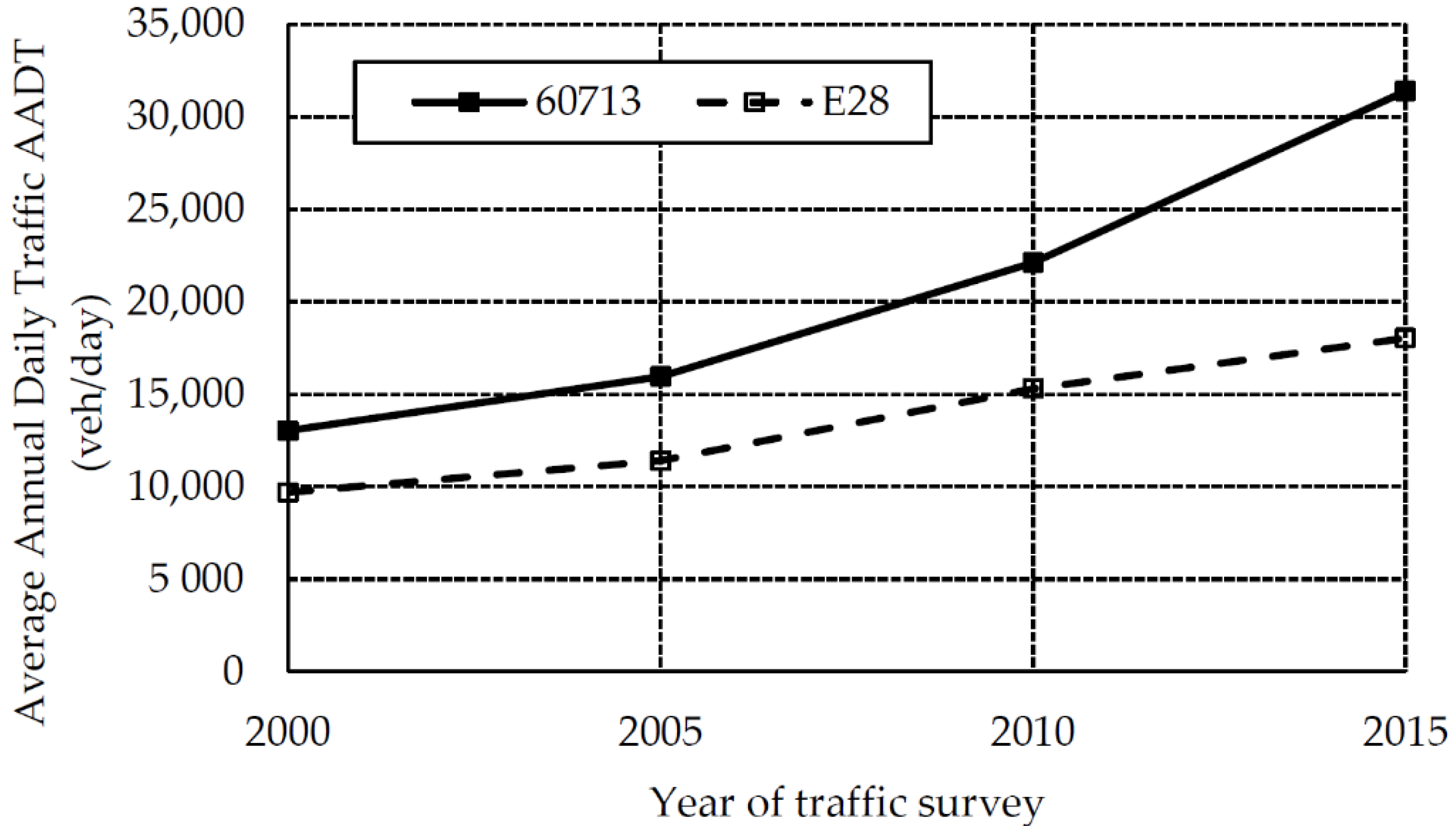
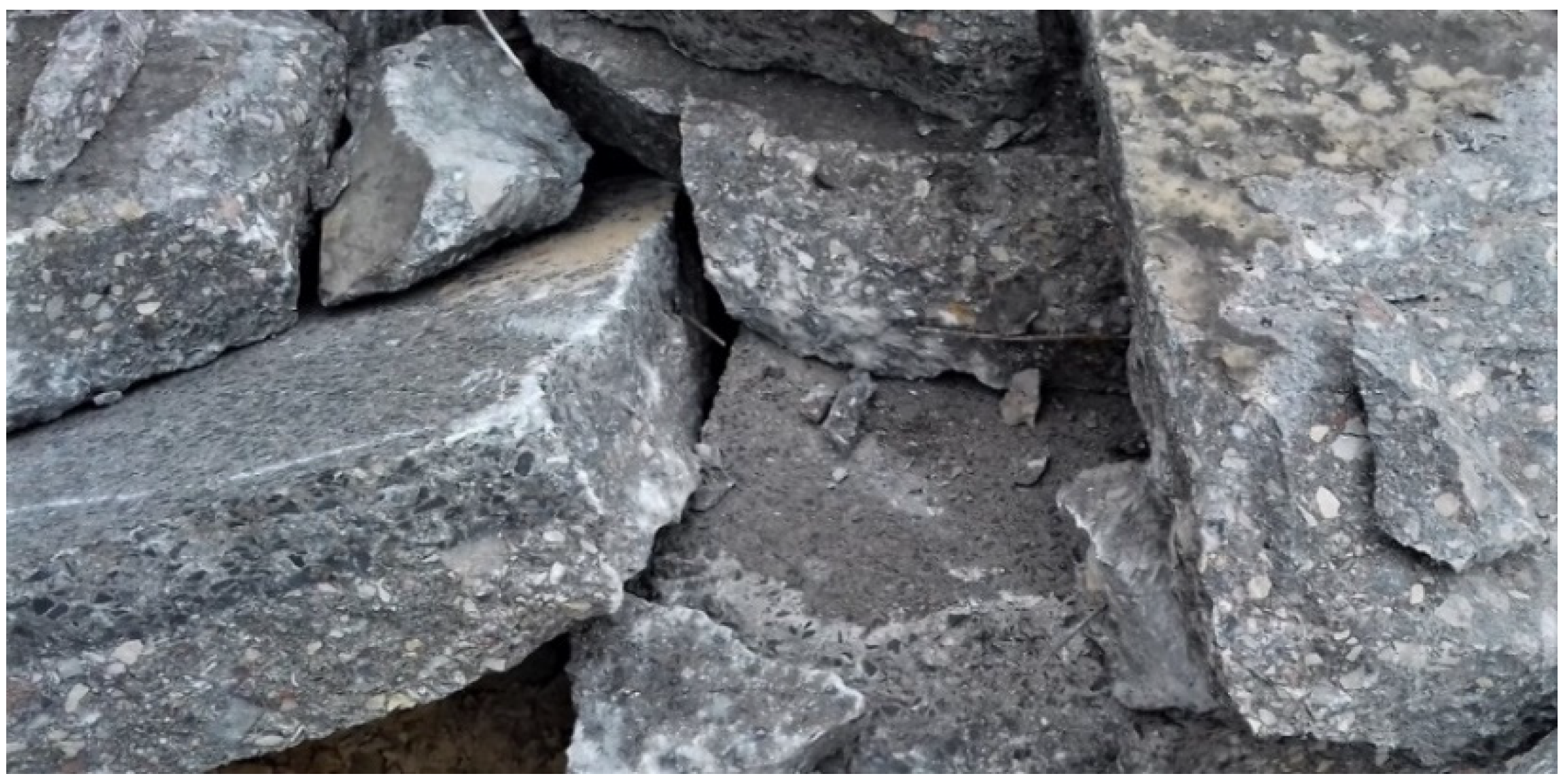
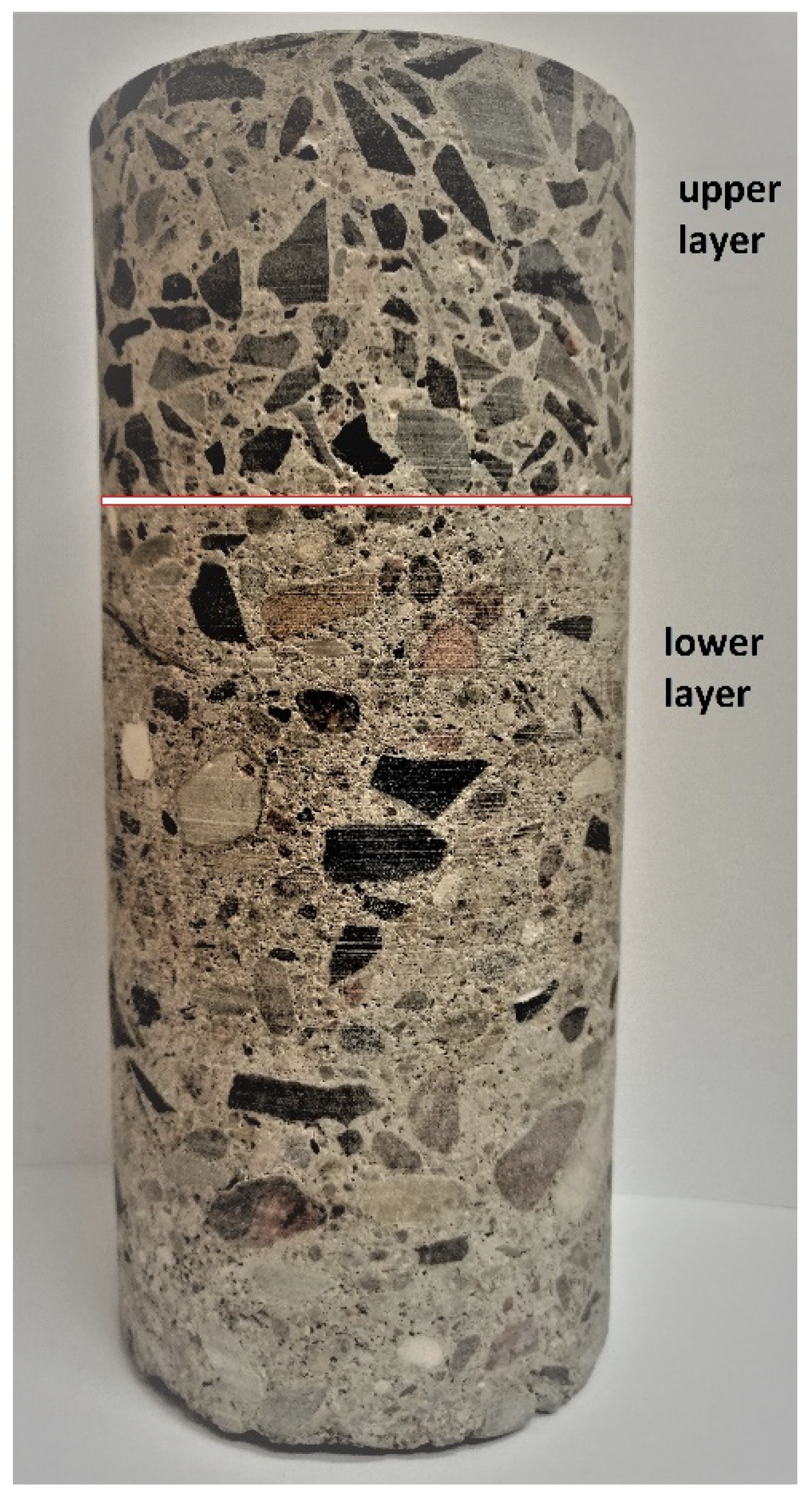


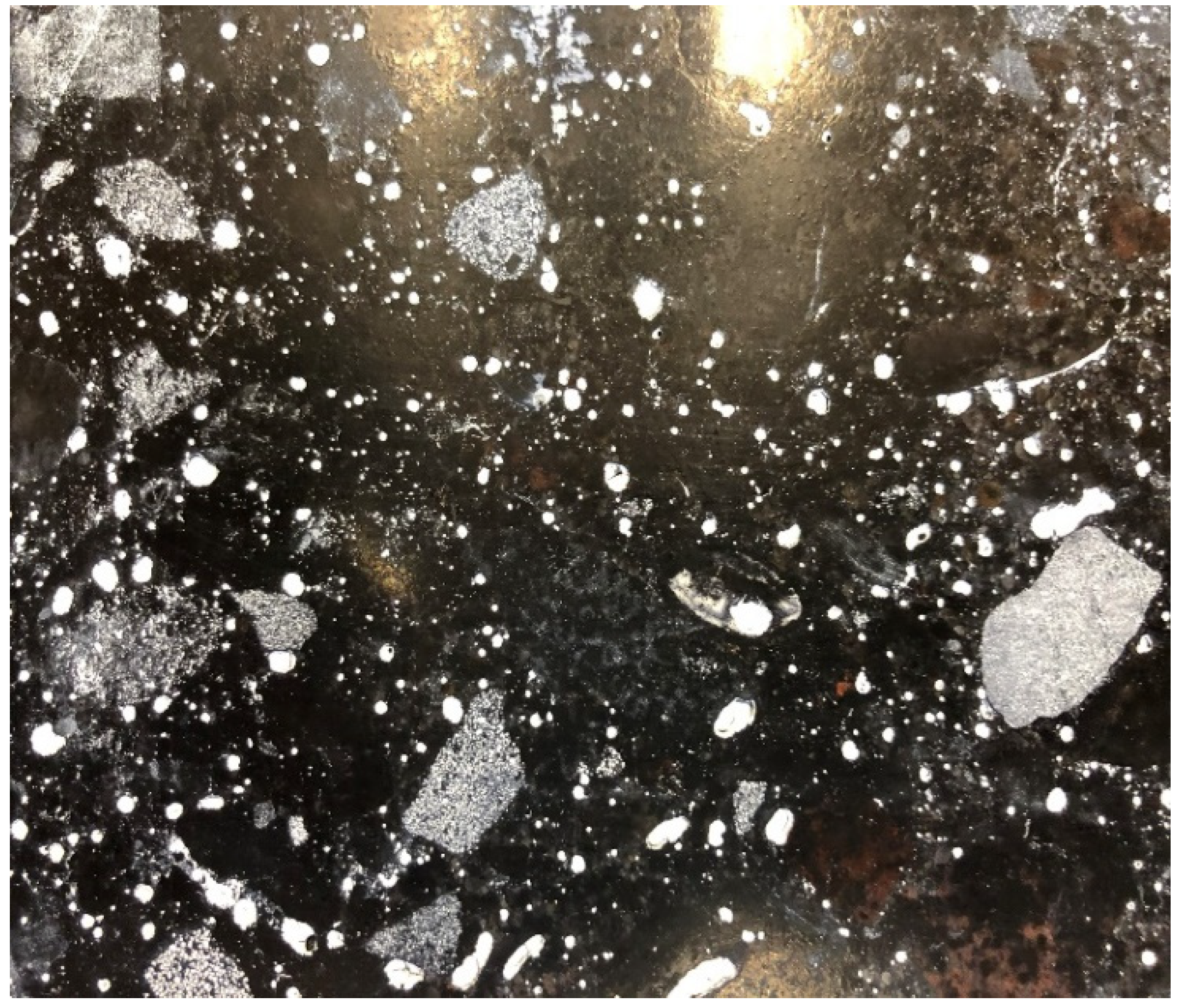
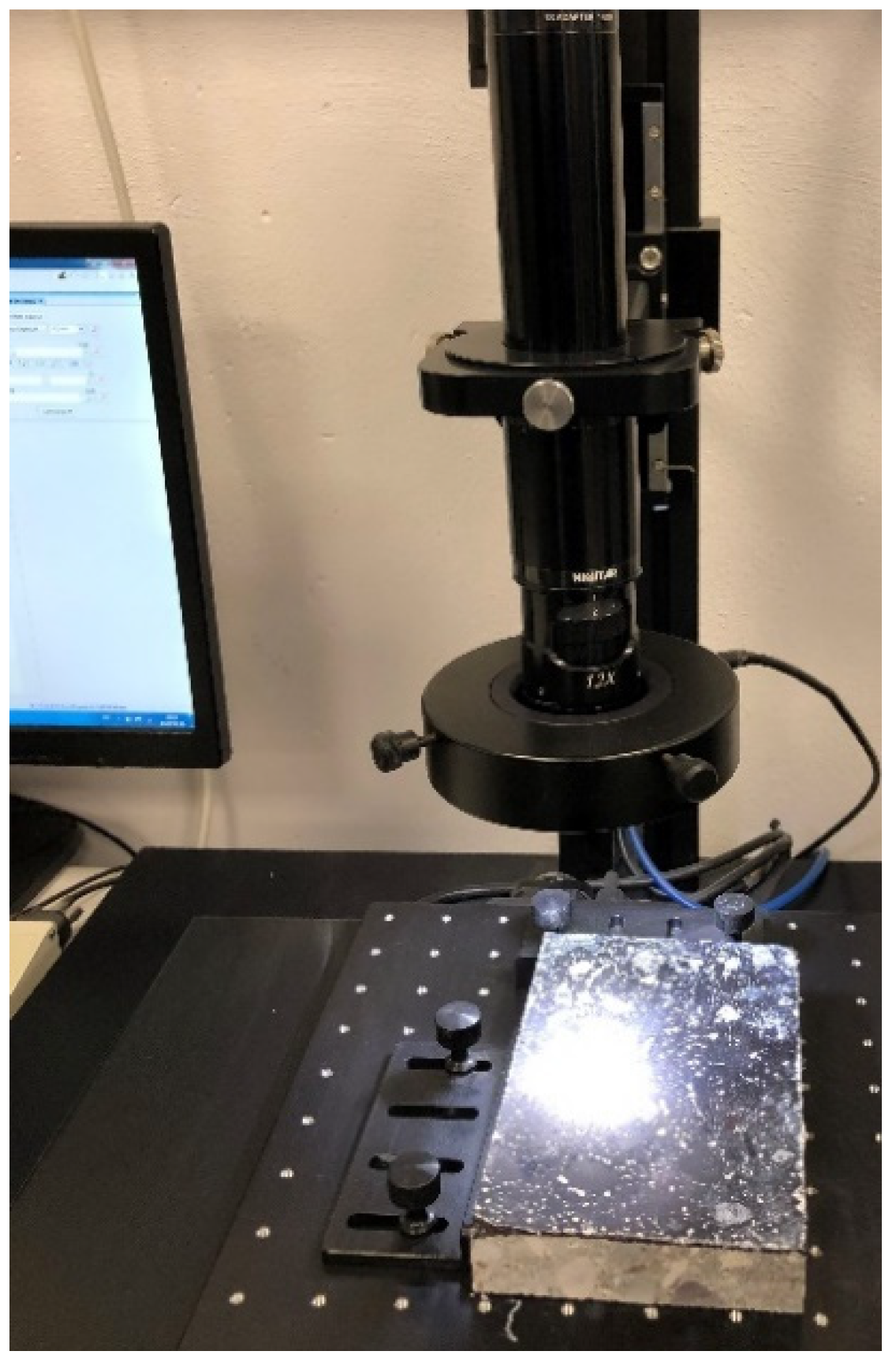
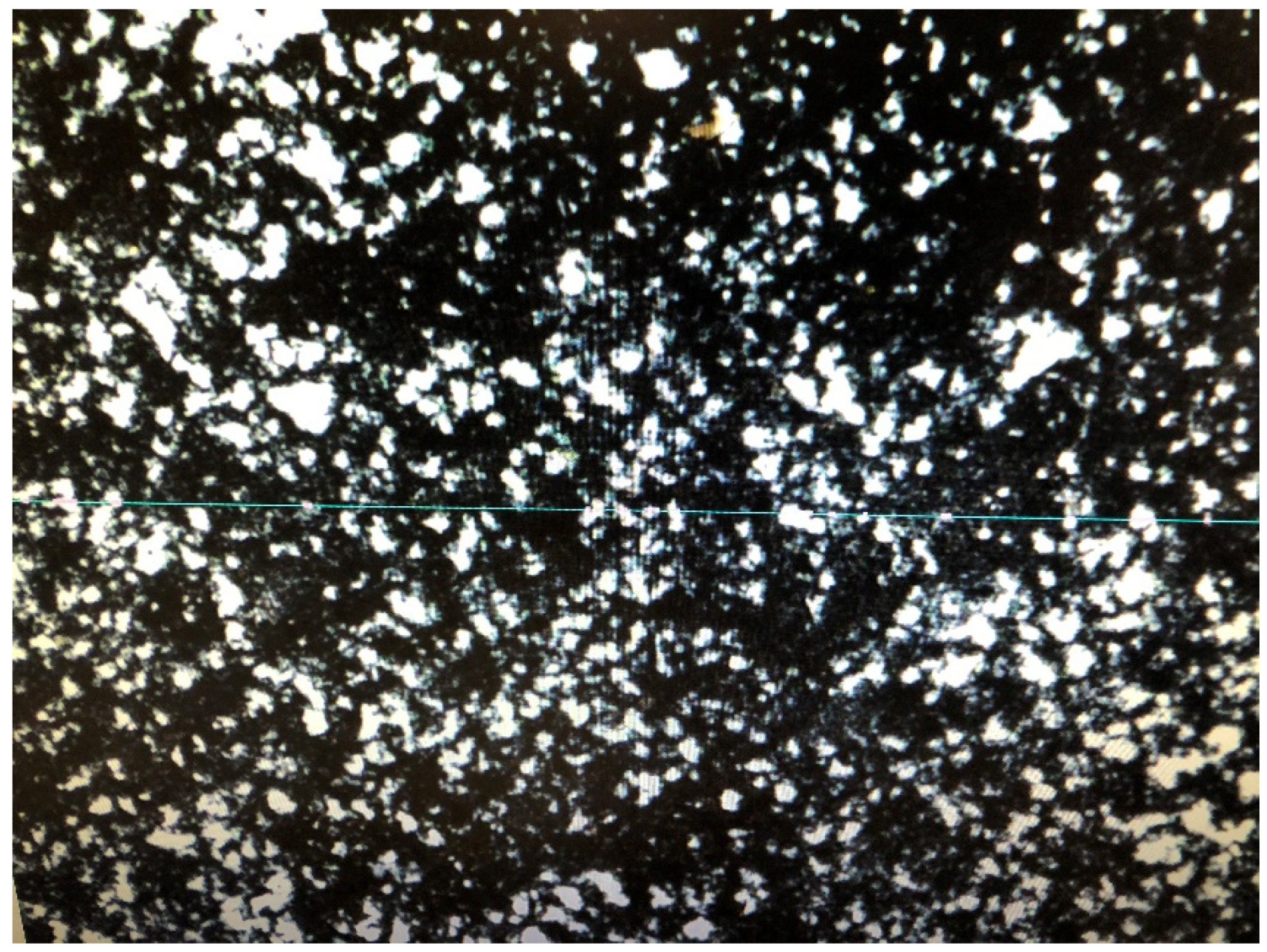

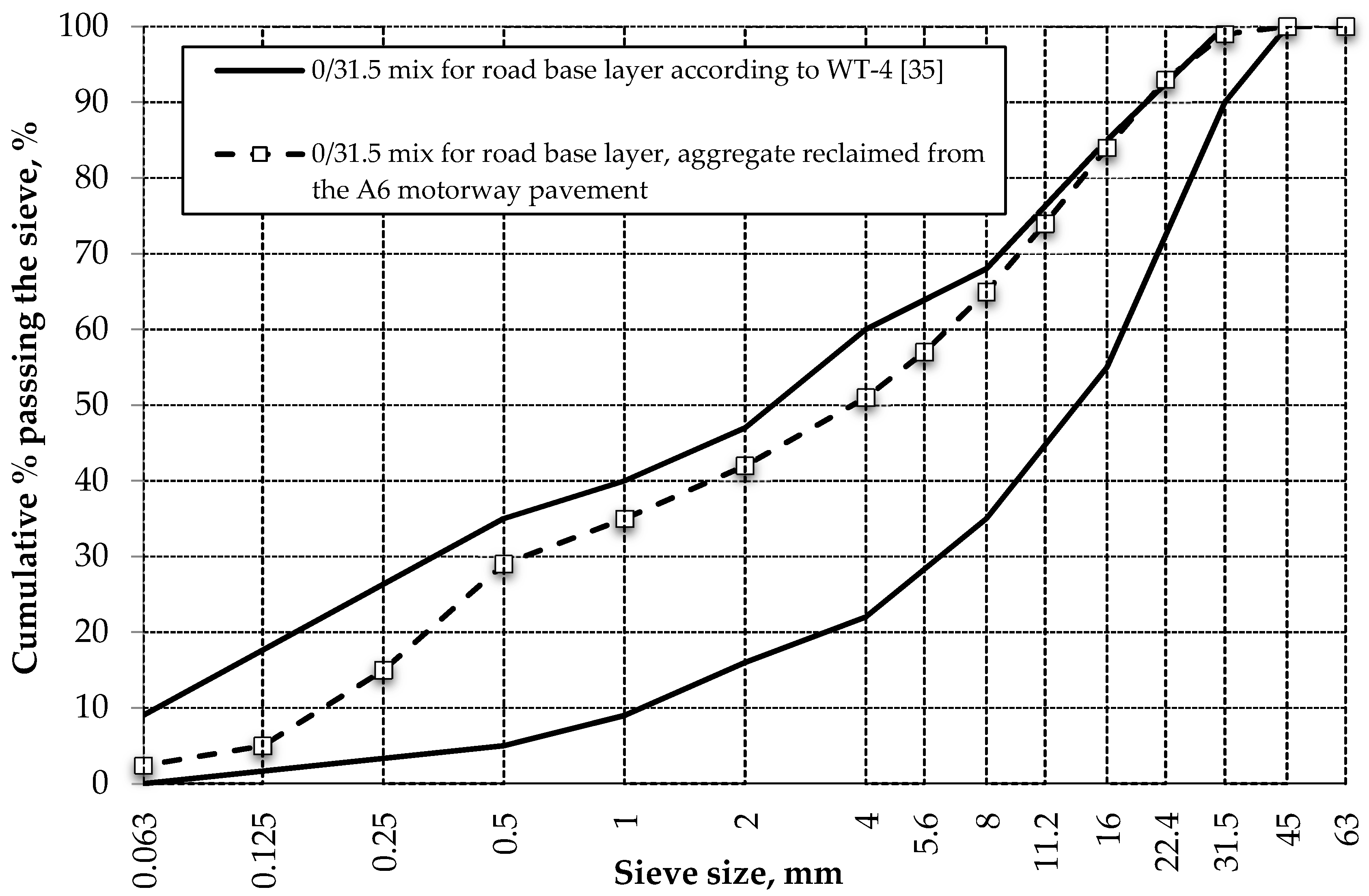
| No. | 1 | 2 | 3 | 4 | 5 | 6 | 7 | 8 | 9 | 10 | 11 | 12 | 13 | 14 | 15 | 16 | Mean |
|---|---|---|---|---|---|---|---|---|---|---|---|---|---|---|---|---|---|
| Upper layer | 74 | 75 | 81 | 80 | 83 | 71 | 85 | 72 | 83 | 70 | 74 | 80 | 75 | 80 | 70 | 75 | 77 |
| Lower layer | 130 | 128 | 130 | 130 | 125 | 130 | 130 | 130 | 135 | 140 | 130 | 130 | 135 | 130 | 135 | 125 | 131 |
| Concrete pavement | 204 | 203 | 211 | 210 | 208 | 201 | 215 | 202 | 218 | 210 | 204 | 210 | 210 | 210 | 205 | 200 | 208 |
| No. | Upper Layer (kg/m3) | Lower Layer (kg/m3) | Mean Value (kg/m3) |
|---|---|---|---|
| 1 | 2506 | - | 2515 |
| 2 | 2499 | ||
| 3 | 2541 | ||
| 4 | - | 2415 | 2404 |
| 5 | 2373 | ||
| 6 | 2425 |
| No. | Compressive Strength-Upper Layer (MPa) | Compressive Strength-Lower Layer (MPa) | Mean Compressive Strength (MPa) | Compressive Strength Class of Concrete According to EN 206:2014-04 [26] | Compressive Strength Class of Concrete According to EN 13877-2:2013-08 [27] |
|---|---|---|---|---|---|
| 1 | 66.5 | - | 65.8 | C55/67 | CC55 |
| 2 | 65.9 | ||||
| 3 | 65.1 | ||||
| 4 | - | 50.2 | 51.2 | C40/50 | CC40 |
| 5 | 49.0 | ||||
| 6 | 54.4 |
| No. | Water Absorption Upper Layer (%) | Water Absorption Lower Layer (%) | Mean Absorption Value (%) |
|---|---|---|---|
| 1 | 3.3 | - | 3.4 |
| 2 | 3.4 | ||
| 3 | 3.5 | ||
| 4 | - | 3.4 | 3.5 |
| 5 | 3.5 | ||
| 6 | 3.5 |
| No. | Rc (MPa) | Rc150 (MPa) | ΔR (%) | ΔM (%) |
|---|---|---|---|---|
| 1 g | 66.5 | 57.5 | 16.2 | 0.18 |
| 2 g | 65.9 | 57.8 | ||
| 3 g | 65.1 | 50.2 | ||
| 4 d | 50.2 | 48.2 | 6.1 | 0.12 |
| 5 d | 49.0 | 43.1 | ||
| 6 d | 54.4 | 53.0 |
| No. | Mass Loss (kg/m2) | Mean Mass Loss (kg/m2) | ||
|---|---|---|---|---|
| After 28 Cycles | After 56 Cycles | After 28 Cycles | After 56 Cycles | |
| 1 | 0.13 | 0.21 | 0.09 | 0.65 |
| 2 | 0.11 | 0.43 | ||
| 3 | 0.04 | 1.29 | ||
| No. | Property | Unit | Result | |
|---|---|---|---|---|
| 1 | compressive strength according to EN 12390-3:2019 [13] | Upper layer | MPa | 62.9 |
| Lower layer | MPa | 49.9 | ||
| 2 | tensile splitting strength of the lower layer concrete, according to EN 12390-6:2019 [22] | MPa | 5.0 | |
| 3 | absorption (teste don the entire core) according to PN-B-06250:1988 [15] | % | 4.0 | |
| 4 | freeze-thaw resistance of the upper layer concrete according to PN-B-06250:1988 [15] | ΔR | % | 3.8 |
| ΔM | % | 0.6 | ||
| 5 | water tightness of the upper layer concrete according to PN-B-06250:1988 [15] | mm | 15 | |
| 6 | water tightness of the upper layer concrete according to EN 12390-8:2011 [23] | mm | 10 | |
| Parameter | Unit | Sample No. 1.1 | Sample No. 1.2 | Sample No. 2.1 | Sample No. 2.2 |
|---|---|---|---|---|---|
| Total traverse length, T | mm | 2.464 | 2.464 | 2.464 | 2.464 |
| Total air content, A | % | 5.4 | 5.4 | 6.1 | 6.0 |
| Total number of chords measured, N | 861 | 877 | 939 | 863 | |
| Specific surface of the air void system, α | mm−1 | 26 | 23.3 | 24.9 | 23.2 |
| Paste/ air ratio, R | % | 4.8 | 4.8 | 4.2 | 4.3 |
| Spacing factor, L | mm | 0.18 | 0.20 | 0.17 | 0.19 |
| Micro air void content, A300 | % | 1.64 | 1.57 | 1.86 | 1.51 |
| Size Range (µm) | Sample No. 1.1 | Sample No. 1.2 | Sample No. 2.1 | Sample No. 2.2 |
|---|---|---|---|---|
| Number of Recorded Chords (voids) | Number of Recorded Chords (voids) | Number of Recorded Chords (voids) | Number of Recorded Chords (voids) | |
| 0 to 10 | 120 | 108 | 100 | 92 |
| 15 to 20 | 95 | 80 | 120 | 108 |
| 25 to 30 | 56 | 53 | 64 | 66 |
| 35 to 40 | 63 | 53 | 73 | 65 |
| 45 to 50 | 49 | 32 | 61 | 41 |
| 55 to 60 | 47 | 45 | 42 | 55 |
| 65 to 80 | 78 | 75 | 76 | 65 |
| 85 to 100 | 60 | 39 | 60 | 49 |
| 105 to 120 | 23 | 43 | 48 | 40 |
| 125 to 140 | 38 | 31 | 38 | 29 |
| 145 to 160 | 27 | 24 | 29 | 23 |
| 165 to 180 | 17 | 10 | 20 | 22 |
| 185 to 200 | 14 | 5 | 23 | 12 |
| 205 to 220 | 10 | 7 | 11 | 18 |
| 225 to 240 | 14 | 18 | 9 | 15 |
| 245 to 260 | 5 | 7 | 13 | 13 |
| 265 to 280 | 9 | 10 | 10 | 8 |
| 285 to 300 | 9 | 4 | 10 | 6 |
| 305 to 350 | 15 | 16 | 19 | 24 |
| 355 to 400 | 15 | 6 | 14 | 8 |
| 405 to 450 | 11 | 12 | 13 | 10 |
| 455 to 500 | 17 | 21 | 11 | 8 |
| 505 to 1000 | 57 | 59 | 52 | 63 |
| 1005 to 1500 | 9 | 16 | 17 | 18 |
| 1505 to 2000 | 2 | 2 | 6 | 4 |
| 2005 to 2500 | 1 | 0 | 0 | 1 |
| 2505 to 3000 | 0 | 1 | 0 | 0 |
| 3005 to 4000 | 0 | 0 | 0 | 0 |
| Property | Reference Standard | Unit | Aggregate Reclaimed from the A6 Motorway Pavement | Requirements acc. to WT-4 [35] Code of Practice | |
|---|---|---|---|---|---|
| Subgrade and Sub-Base | Road Base | ||||
| Aggregate crushing value 10/14 | EN 1097-2:2010 [18] | % | 31.8 | LA50 1 | LA40 2 |
| Absorption 8/16 | EN 1097-6:2013-11 [19] | % | 3.8 | WA24 2 | WA24 2 |
| Freeze-thaw resistance 8/16 | EN 1367-1:2007 3 [20] | % | 3.5 | F10 | F10 |
© 2020 by the authors. Licensee MDPI, Basel, Switzerland. This article is an open access article distributed under the terms and conditions of the Creative Commons Attribution (CC BY) license (http://creativecommons.org/licenses/by/4.0/).
Share and Cite
Rudnicki, T.; Jurczak, R. Recycling of a Concrete Pavement after over 80 Years in Service. Materials 2020, 13, 2262. https://doi.org/10.3390/ma13102262
Rudnicki T, Jurczak R. Recycling of a Concrete Pavement after over 80 Years in Service. Materials. 2020; 13(10):2262. https://doi.org/10.3390/ma13102262
Chicago/Turabian StyleRudnicki, Tomasz, and Robert Jurczak. 2020. "Recycling of a Concrete Pavement after over 80 Years in Service" Materials 13, no. 10: 2262. https://doi.org/10.3390/ma13102262






